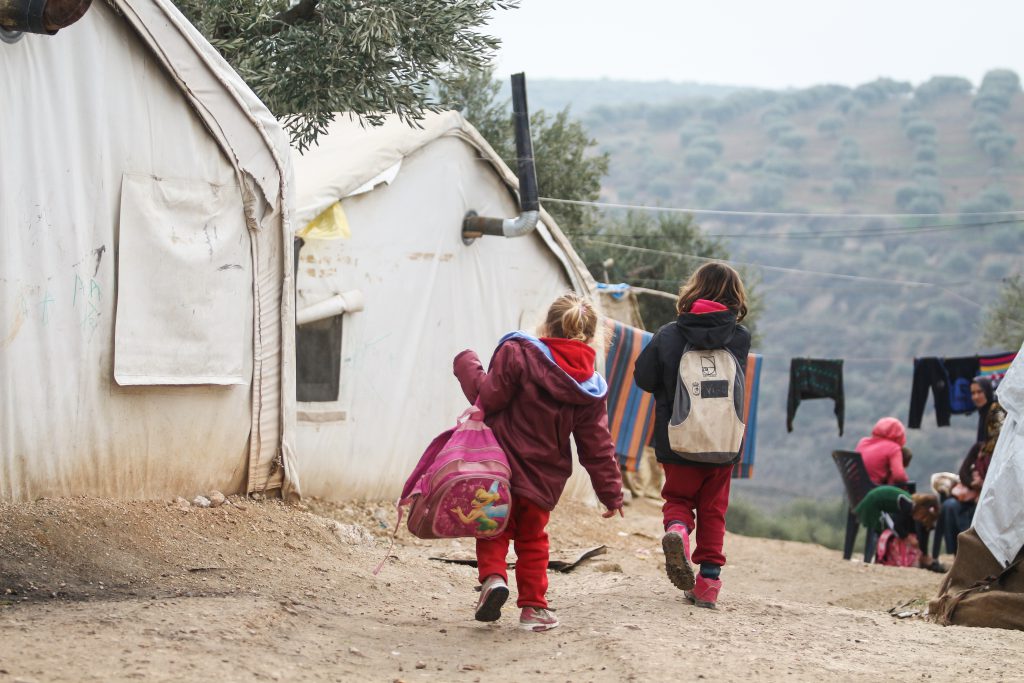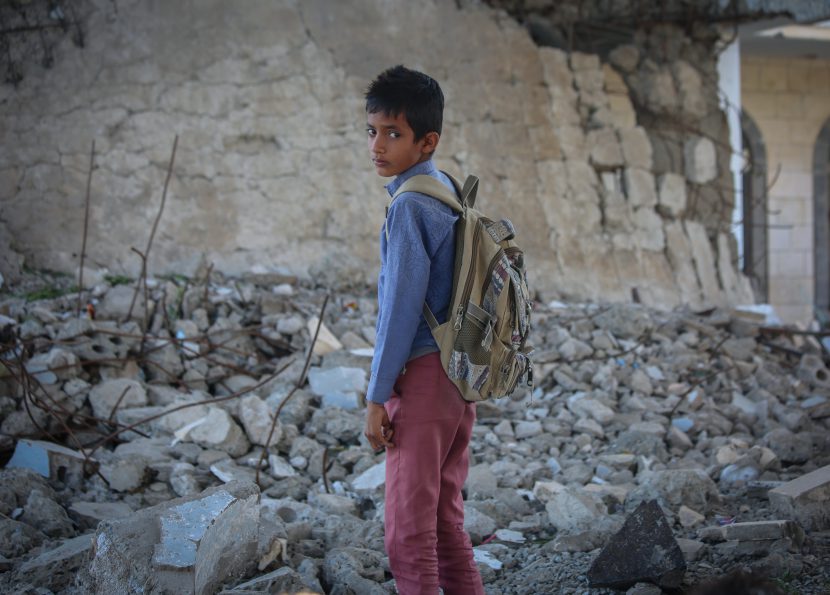In armed conflicts, education is frequently not considered to be as important as other rights and it is often overlooked. Nevertheless, education in these situations is vital for every child since it provides them with much more than the right to learn. It is of major importance for their psychological and physical well-being. Likewise, education provides social protection to children.
Education in emergencies
Education in emergencies is an essential life-saving response that should be seen as a priority, it is used in situations of armed conflicts or disasters caused by natural hazards or pandemics. These situations destroy, in a short period of time, children’s life, care and education facilities; interrupting, denying, and hindering the fulfillment of the right to education (British Institute of International and Comparative Law,2020). Consequently, the aim of emergency education is to protect children and safeguard their right to education.
The high number of countries affected by armed conflicts leaves many children out of school; in the decade of 2008, thirty-five countries suffered conflicts and the average duration of these conflicts was of twelve years (UNESCO, 2012). Consequently, almost 50 million children of primary and lower-secondary age are out of school, of which 28.5 million are primary-age, girls accounting for half of them(Save the Children, 2014).
Education as a tool to provide psychological protection
Armed conflicts have a serious psychological impact on children due to multiple reasons, such as wartime stress, their parents’ or close relatives’ death or long-term separation from their families. Likewise, many children are highly exposed to combat or take an active part in conflicts. They suffer constant violence, either as a victim or a witness.
Moreover, many of them are kidnapped, tortured, or arrested. In countries affected by armed conflicts, one-quarter of the children have reported that they have been subjected to torture, over half of them stated that they have been threatened by the armed forces, and 16% of children have been imprisoned in areas of conflicts (Macksoud, 2000).
All these situations make children extremely insecure and vulnerable, triggering the development of certain phobias, as well as fearful and anxiety reactions. Education can notably reduce the psychosocial impact of trauma and displacement. Children are in the middle of their development process; thus, their personalities are being formed and their skills improve by learning. Since this development cannot be carried out in isolation children need their families and schools to help them during their development process (UNHCR,1988)
Education promotes children’s psychological well-being by complying with two main objectives. Firstly, its objective is to act as a preventive measure to support children, so that they do not develop traumas or any other psychological problem, caused by the bad experiences they have suffered. Secondly, education provides special assistance to guarantee the full healing and recovery of children who have been injured or need special attention (UNHCR,1988).
“Educational programs shall be aimed to support healing processes and to establish a sense of normality. This should include establishing daily routines of family and community life, opportunities for expression and structured activities such as school, play and sports.”
– UNGA, 1996
Moreover, children’s emotional well-being is highly affected by the protection and care given by their families; in some situations, the child’s family might be even more psychologically affected than their children. Thus, they might not be able to help their children psychologically cope with the situation they are going through. On the other hand, many children do not have close relatives to support them. Consequently, children require trained and specialized teachers to regularly support them during these times.
Education as a tool to provide social and physical protection
Education is also essential to provide children with physical and social protection. When armed conflicts strike countries, they result in the absolute poverty and devastation of most of their population. Consequently, children are likely to suffer malnutrition and illnesses because families frequently lack the necessary resources to cover their children’s essential necessities.
In addition, children may be disregarded by their families as many of their family members may be physically or psychologically affected by conflicts and they may not be able to take care of their children in a proper way. Therefore, children need schools to offer them everything that their families are not able to. Besides, schools usually provide children food, water, and sanitation facilities so that their necessities are met.

Moreover, children who have been directly exposed to conflicts may have suffered physical violence and require much more attention and care. They could need facilities such as prosthesis, physiotherapy, and rehabilitative work. Additionally, more psychological support shall be offered to them to help them accept and cope with their condition (Macksoud, 2000). Schools usually provide these children with the special needs they require and give them special attention and care.
Furthermore, educational, and recreational activities have a protective role on children and adolescents. They support children who have physical or mental health problems and can reveal which of the students that attend schools are being subjected to abuses or exploitation outside of schools and help them escape from these abuses.
In addition, education has the power of saving lives and avoiding children’s injuries, by providing an alternative to children who may otherwise be recruited into armed conflicts by militias. Likewise, education highly decreases the chances of prostitution, early pregnancies, as well as alcohol and drug abuse (Margaret, 2001).
Education can help former child soldiers and vulnerable groups
Children who have been recruited in armed conflicts have been subjected to heavy indoctrination programs that worship violence; consequently, children start to have feelings of revenge and aggression (Macksoud, 2000). Therefore, education can help former child soldiers to normalize life and reintegrate back into society; recreational and cultural activities improve their self-esteem and support them to develop an identity different from that of the soldier (UNGA, 1996).
In addition, education can also help other vulnerable groups to integrate into society, such as refugees, or internally displaced persons, by teaching them the new culture and language (sometimes through special programs) and by providing safe environments where they could feel integrated and build friendships in the new community in which they are living.
The importance of peace education for the future
It is of utmost importance to ensure that the educational content in armed conflicts is not discriminatory, nor includes stereotypes, or uses humiliating images of certain groups in society. It is essential to educate students on the values of peace, responsible citizenship, equality, and tolerance in all circumstances. However, in situations of conflict, this is even more important because it promotes respect for others, as well as peace building, and conflict resolution, and prevents other conflicts from arising. Nevertheless, it is unquestionable that when schools are used as tools for the indoctrination of children and as an incitement of hatred, conflicts are likely to arise.
Education is the main engine in the shaping of children’s minds; teaching students in the culture of peace is more than just the absence of war, it is teaching them how to coexist with people who have different sex, race, language, religion, or culture than them, by remarking the ideas that we are all equal and shall be respectful with each other.
Wars have first been developed in the minds of men. Therefore, “It is in the minds of men that the defenses of peace must be constructed.” (UNESCO Constitution, 1945).
“The wide diffusion of culture, and the education of humanity for justice and liberty and peace are indispensable to the dignity of man and constitute a sacred duty which all the nations must fulfil in a spirit of mutual assistance and concern.”
– UNESCO Constitution, 1945
At Humanium, we support children’s right to education, especially those children who are suffering conflicts. Humanium is currently working on creating a world where all children can enjoy their right to education, regardless of the situation they are going through. We have therefore a strong commitment to raising awareness of this right so that it can be respected.

Moreover, we strive to build resilience in one’s mind and body in order to avoid trauma in the aftermath of armed conflicts. If you want to support us in the implementation of children’s rights worldwide, subscribe to our newsletter or become a member or a volunteer. You can also consider sponsoring a child or making a donation. Join us in taking action for children’s rights worldwide!
Written by Marina Pérez Ortega
References:
British Institute of International and Comparative Law, Protecting Education in Insecurity and Armed Conflict, An International Law Handbook, second edition, retrieved from: https://www.right-to-education.org/sites/right-to-education.org/files/resource-attachments/PEIC_BIICL_international_law_handbook_2020_en.pdf, accessed on 15/04/2022.
MACKSOUD (2000), Helping Children Cope With The Stresses Of War- A Manual For Parents And Children. New York, UNICEF, retrieved from: https://factsforlife.org/pdf/Helping_Children_Cope_with_the_Stresses_of_War.pdf, accessed on 12/04/2022.
MARGARET (2001), Chapter 1 “Education in Emergencies”. In: Learning for a future: refugee education in developing countries. UNHCR, retrieved from: https://www.unhcr.org/4a1d5ba36.pdf, accessed on 12/04/2022.
SAVE THE CHILDREN (2013), Attacks On education the impact of conflict and grave violations on children’s futures, London, 2013, retrieved from: https://resourcecentre.savethechildren.net/pdf/attacks_on_education_final_1.pdf/, accessed on 13/04/2022.
UNESCO (2012), EFA Global Monitoring Report: The hidden crisis: Armed conflict and education: France, 2012, retrieved from: https://unesdoc.unesco.org/ark:/48223/pf0000190743, accessed on 11/04/2022
UNESCO (1945), Constitution of the United Nations Educational, Scientific & Cultural Organization,
retrieved from: http://www.un-documents.net/unesco-c.htm, accessed on 15/04/2022.
UNGA (1996), Doc. A/51/306, Impact of armed conflict on children, Report of the expert of the Secretary-General, Ms. Graça Machel (Resolution 48/157), retrieved from: https://digitallibrary.un.org/record/223213#record-files-collapse-header, accessed on 11/04/2022.
UNHCR (1988), Refugee Children: Guidelines on Protection and Care, retrieved from: https://www.unhcr.org/protection/children/3b84c6c67/refugee-children-guidelines-protection-care.html,p.13, accessed on 15/04/2022.


